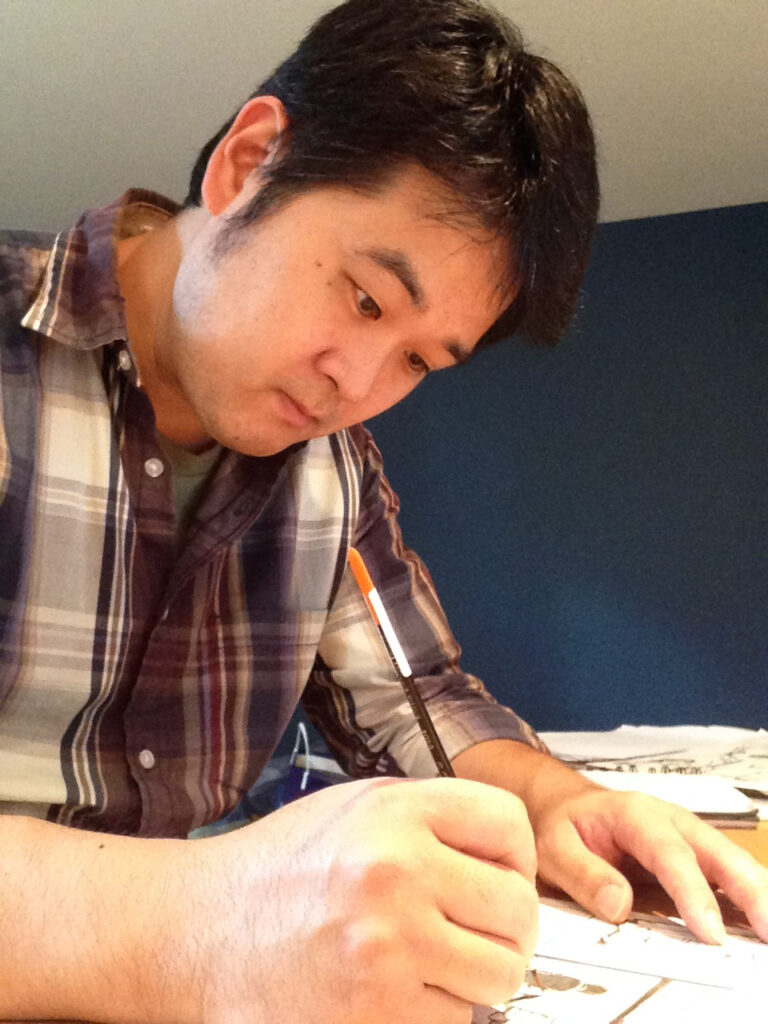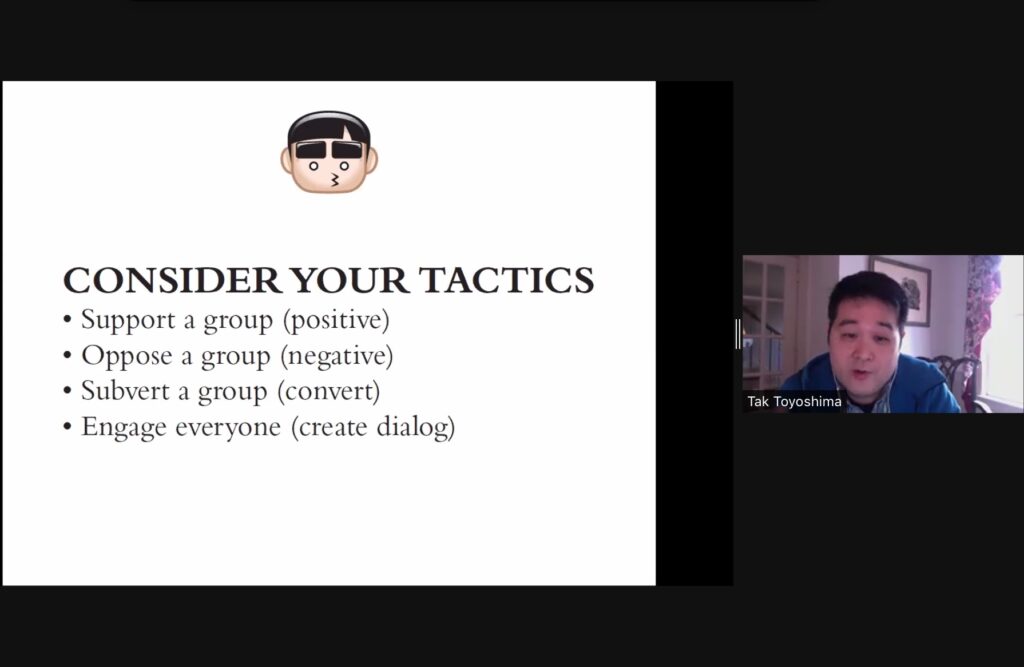Teach-In on Race: Tak Toyoshima on Using Art to Heal the World

Comic artist Tak Toyoshima had been working as an inker on mainstream comics like The Tick and for large publishers like Marvel and Disney, but after a few years of signing autographs at comic shows for work he didn’t create, he felt like he had more to say.
“I still want that line of people waiting for an autograph, but what stories can I tell that nobody else knows, that I know better than anybody else? And really that became stories about my life,” Toyoshima said.
That was how Secret Asian Man was born. The comic strip began life at the start of the new millennium as a two-page monthly in a Boston arts magazine, grew up to be a weekly fixture in the Weekly Dig, and in 2006 was scouted for syndication by United Features, giving Toyoshima a national audience for his stories of life as an Asian American man in the 21st century.
As keynote speaker of this year’s Teach-In on Race, Toyoshima talked to Emerson students, faculty, and staff about his early life growing up in New York City as the son of Japanese immigrant artists, his career in comics, and ways to use your art to make positive change in the world.
Watch: Teach-In on Race Playlist
Here’s some of his advice.
On creating Kwok, a self-published comic short story Toyoshima created to raise money for the Greater Boston Chinese Golden Age Center in Boston’s Chinatown:
“That was probably one of the most rewarding things I’ve ever done, as far as being able to meet these people, drop off the check, see the completely surprised look in their eyes, knowing that that check — it’s not a million dollar check or anything — but it definitely went to help very real efforts in the local community. It’s something that I would urge anybody with any kind of ability, if you wanted to really get reward out of it, don’t think of the money or anything like that. Think of the positive aspects you can bring to your community through an effort like that. It’s its own reward, trust me.”
Stay focused:
“As far as making positive change, it is something that you’ll have to think about so to you, positive change could be somebody else’s negative change. In terms of your motivation for doing it, stay true to what your goal is, what is your message that you want to get out there? I feel like largely, most people can agree on most things that are positive, but you’re not going to get everybody, so, just stick to your guns and keep focused on what that positive side of that changes.”
Toyoshima’s preferred tactic for making change (the others are supporting, opposing, and subverting):
“The last [tactic] is where you’re engaging everyone. This is probably my, now, favorite method. You want to create a dialogue, because in the end, you’re not going to change people’s minds by telling them they’re dumb. On the far end of the … spectrum, you’re going to be preaching to the choir.
[A reviewer said of my work] that it was more of a bridge text, where it didn’t seem I was overly taking one side or the other. I was more interested in bringing the sides together so they can have a conversation on their own. The last thing I wanted to do was stand on a soapbox and preach to everybody what they should be thinking, but that’s not to say that the topics that I brought up, I thought weren’t, you know, worth the conversation or further dialogue.
It took a while to get to that point, but I think partly it was due to some frustration of feeling like it’s great to throw red meat at certain crowds and they’ll eat it up. But in the end, when your ultimate goal is to make things better for everyone, … you’re not doing anybody any favors by stomping on them and just keeping them down like that, or blindly supporting somebody …”

Seize the moment:
“During shutdown, when the spike in anti-Asian violence started happening, on the one hand, it was amazing to see that much attention focused on that issue. On the other hand, like most social issues like that, it quickly went away. It stuck around for a few, I don’t know, weeks, maybe a month or month and a half, and then it really started dying out.
Know… that you have to take full advantage of those little windows of opportunity and reach out as much as you can, do as [many] positive things as you can, but know…that [the violence] had happened before and that it’s still happening now, it just doesn’t rise to the level of media attention. [That] doesn’t mean you shouldn’t do it on your own, because if nobody does it, then they’re really not going to pay attention. The more of us get together and kind of team up and do those things, the media is going to look every now and then and be like, ‘Hmm, you know, these guys are still at it, maybe there’s something here.’
Read: Teach-In on Race: Combating Anti-Asian Hate
Understand that you will meet with resistance:
“Do you think the world will ascribe to your point of view? Again, getting back to, if you’re fighting against a group, guess what? That group is also made of people that were born and raised and have a whole different set of experiences that brought them to where they are. …
I would say, not to discourage you putting your views out, just keep in mind that not everybody is going to see the light, and ultimately art is subjective and meant to be interpreted, so are you actually prepared for your audience’s reaction? You make this beautiful piece, you work your butt off, get it published, and you have people crapping all over it. Are you ready for that? Can you take that kind of criticism and negative… feedback? Prepare yourself for that.”
Always look ahead:
“Achieving the goal will just set up the next one. So obviously, let’s say you get that wall at the coffee shop that you’ve been eyeballing for months, and that feels great, you got it up there. Now that’s going to trigger you to want to step it up to do a gallery show. You should keep going on and on, and definitely just keep on pushing, because guess what? You made it to that wall in the coffee shop, what’s stopping you from the next step?
Gotta keep that [up] in order to make these deep lasting changes. It’s got to be a sustained and prolonged effort. Don’t just put out a lot of half-assed … work, really apply yourself. People will recognize the amount of work that you put in.”
Start small:
“Before changing the world, try changing a world. Choose an individual, choose a small group, something like that, and try to figure out a way to use your art and somehow benefit them.”
Find co-conspirators:
“Then ultimately, make allies, because when you collaborate, you’re going to find that you are not alone. There’s a ton of people that want to help out. Collectively your voices are going to go way further, and just take your ego out of it. [Keep] the goal in mind of bringing people together and you’re going to find it’s going to be a lot more rewarding than just banging your head against the table by yourself.”
Categories